Intel Core i7-10700 vs Core i7-10700K Review: Is 65W Comet Lake an Option?
by Dr. Ian Cutress on January 21, 2021 10:30 AM EST- Posted in
- CPUs
- Intel
- Core i7
- Z490
- 10th Gen Core
- Comet Lake
- i7-10700K
- i7-10700
CPU Tests: Simulation
Simulation and Science have a lot of overlap in the benchmarking world, however for this distinction we’re separating into two segments mostly based on the utility of the resulting data. The benchmarks that fall under Science have a distinct use for the data they output – in our Simulation section, these act more like synthetics but at some level are still trying to simulate a given environment.
DigiCortex v1.35: link
DigiCortex is a pet project for the visualization of neuron and synapse activity in the brain. The software comes with a variety of benchmark modes, and we take the small benchmark which runs a 32k neuron/1.8B synapse simulation, similar to a small slug.
The results on the output are given as a fraction of whether the system can simulate in real-time, so anything above a value of one is suitable for real-time work. The benchmark offers a 'no firing synapse' mode, which in essence detects DRAM and bus speed, however we take the firing mode which adds CPU work with every firing.
The software originally shipped with a benchmark that recorded the first few cycles and output a result. So while fast multi-threaded processors this made the benchmark last less than a few seconds, slow dual-core processors could be running for almost an hour. There is also the issue of DigiCortex starting with a base neuron/synapse map in ‘off mode’, giving a high result in the first few cycles as none of the nodes are currently active. We found that the performance settles down into a steady state after a while (when the model is actively in use), so we asked the author to allow for a ‘warm-up’ phase and for the benchmark to be the average over a second sample time.
For our test, we give the benchmark 20000 cycles to warm up and then take the data over the next 10000 cycles seconds for the test – on a modern processor this takes 30 seconds and 150 seconds respectively. This is then repeated a minimum of 10 times, with the first three results rejected. Results are shown as a multiple of real-time calculation.
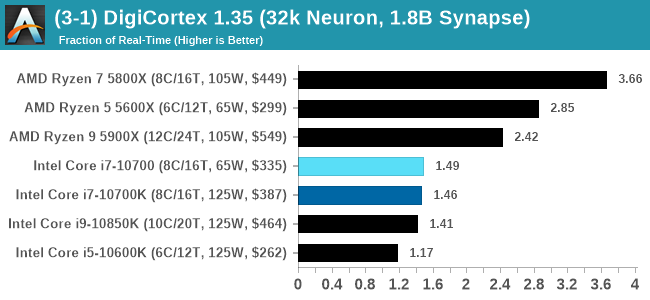
For users wondering why the 5800X wins, it seems that Digicortex prefers single chiplet designs, and the more cores the better. On the Intel side, the 10700 pulls a slight lead.
Dwarf Fortress 0.44.12: Link
Another long standing request for our benchmark suite has been Dwarf Fortress, a popular management/roguelike indie video game, first launched in 2006 and still being regularly updated today, aiming for a Steam launch sometime in the future.
Emulating the ASCII interfaces of old, this title is a rather complex beast, which can generate environments subject to millennia of rule, famous faces, peasants, and key historical figures and events. The further you get into the game, depending on the size of the world, the slower it becomes as it has to simulate more famous people, more world events, and the natural way that humanoid creatures take over an environment. Like some kind of virus.
For our test we’re using DFMark. DFMark is a benchmark built by vorsgren on the Bay12Forums that gives two different modes built on DFHack: world generation and embark. These tests can be configured, but range anywhere from 3 minutes to several hours. After analyzing the test, we ended up going for three different world generation sizes:
- Small, a 65x65 world with 250 years, 10 civilizations and 4 megabeasts
- Medium, a 127x127 world with 550 years, 10 civilizations and 4 megabeasts
- Large, a 257x257 world with 550 years, 40 civilizations and 10 megabeasts
DFMark outputs the time to run any given test, so this is what we use for the output. We loop the small test for as many times possible in 10 minutes, the medium test for as many times in 30 minutes, and the large test for as many times in an hour.
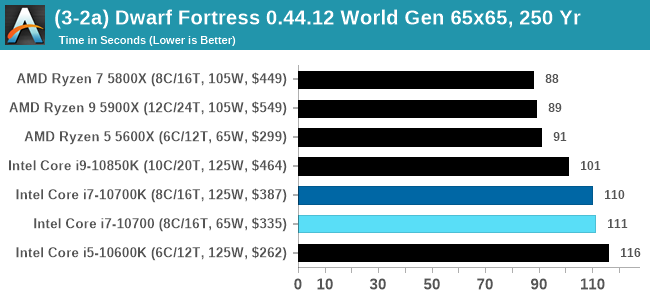
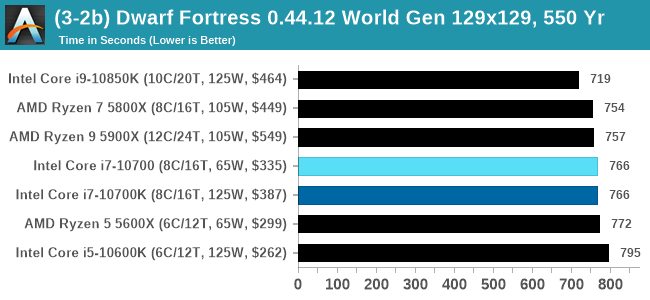
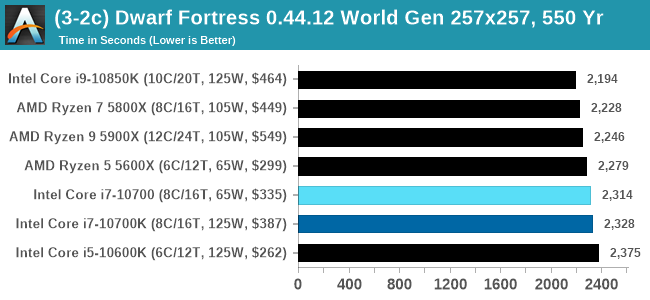
Dolphin v5.0 Emulation: Link
Many emulators are often bound by single thread CPU performance, and general reports tended to suggest that Haswell provided a significant boost to emulator performance. This benchmark runs a Wii program that ray traces a complex 3D scene inside the Dolphin Wii emulator. Performance on this benchmark is a good proxy of the speed of Dolphin CPU emulation, which is an intensive single core task using most aspects of a CPU. Results are given in seconds, where the Wii itself scores 1051 seconds.
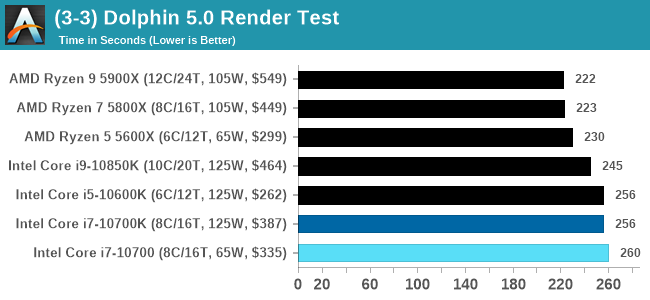












210 Comments
View All Comments
Mr Perfect - Thursday, January 21, 2021 - link
Yeah, if Alder Lake doesn't get things under control later this year, my next ITX build will also be Ryzen. There's just no sense in using a CPU drawing 200+ watts in SFF when cooling the current crop of GPUs is hard enough as it is!DanNeely - Thursday, January 21, 2021 - link
In SFF I suspect you'll be operating well below 215W. If not because the mobo can't supply the power, but because your small form factor cooler can't handle the heat and you're limited to short turbo periods due to thermal throttling.Mr Perfect - Thursday, January 21, 2021 - link
You should well be able to run the 215watt mode if you're daring. Some folks over on r\sffpc use the big CPUs, because the mITX boards have power delivery similar to the ATX boards and do support them. The problem is they report idle temps around 50C and gaming temps around 70C.Personally, I'm just not willing to run those temps. My current ITX build is using an older 95watt CPU(that actually drew 95watts at turbo) and idles at 35C and games around 50C. A new CPU with an idle temp that's the same as my current load temp is just mind boggling.
Dug - Thursday, January 21, 2021 - link
You do realize that 50 and 70c are not anywhere close to being worried about anything? You said personally you aren't willing to run those temps. Have you even looked into what modern processors are capable of? Have you ever used a laptop, which will hit that temp just by opening the lid?Calin - Friday, January 22, 2021 - link
I remember one processor (or maybe GPU) had temperature limits (internal temperature, as measured on-die) of a bit over 100 Celsius. It might have been an NVidia chip, however I remember Intel coming close to that.Compared to that, 50 Celsius at idle and 70 at load is positively arctic ;)
at_clucks - Friday, January 22, 2021 - link
Perhaps idling at 50 is not outstanding but full load at 70 definitely is, especially for a cramped SFF PC.Spunjji - Friday, January 22, 2021 - link
It all depends on the fan speeds, really. 50 at idle is extremely impressive if the system is silent!Wineohe - Thursday, January 21, 2021 - link
I too just picked up a 5600X for list of $299 to build a NAS. Paired it with a $120 B550, some extra RAM and a video card I had collecting dust. Wish I would have researched the case more though. Ironically it’s considerably faster than my desktop with it’s pokey old i7-6800K. I’ll wait until the 5950X comes more readily available for a upgrade.schujj07 - Friday, January 22, 2021 - link
Using a 5600X for a NAS, I assume it is for home and not enterprise, is total overkill. You would be fine using an Athlon 200G in a home NAS and would never notice the difference.magreen - Friday, January 22, 2021 - link
I run a pentium M for my Ubuntu server/NAS